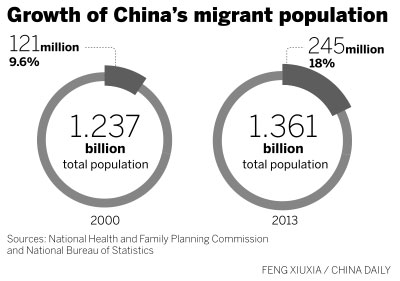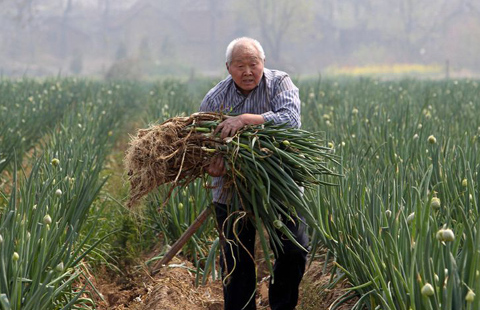Coming or going, migrants alter dynamics of labor
Updated: 2015-04-13 06:42
By WANG XIAODONG(China Daily)
|
||||||||
 |
|
[Graphics by Feng Xiuxia/China Daily] |
The number of migrant workers in China more than doubled from 2000 to 2013-from 121 million to 245 million, and ballooned from 9.6 percent of the country's total population to 18 percent in 2013, 21st Century Business Herald reported on Sunday.
Anhui province is the largest exporter of migrant workers in China, and a lot of them are heading to Guangdong province, which has the largest migrant population.
Most migrants come from six provinces-Sichuan, Hunan, Henan, Guizhou in Central and Southwest China, and Jiangxi and Anhui provinces in East China. About 71 percent of the cross-province movers in 2013 started in those six provinces, according to the report, quoting sources at the National Health and Family Planning Commission, which released a report in November.
About 8.5 million people flowed out of Anhui province last year, or 14 percent of the province's total population.
On the receiving side, Guangdong province was No 1, attracting 29.5 percent of cross-province movers in 2013, followed by Zhejiang province and Shanghai municipality, the report said.
According to Yuan Xin, a professor of population studies at Nankai University in Tianjin, most migrant workers come from rural areas that have a labor surplus. More than 80 percent are between 16 and 59 years old, said to be the most productive age range.
Because migration brings numerous young labors to big cities, the onset of labor shortages as the permanent population ages has been eased, Yuan said.
"But migration also drains labor from rural areas, which leads to population aging in those areas," he said. "Since 2000, population aging has been more serious in rural areas nationwide than in cities."
As young migrants head to the cities to make a living, a common phenomenon is that elders and children are left behind.
"It is necessary to improve the pension system for the elders in rural areas, so they can enjoy better social security even if left alone by their children," Yuan said.
By the end of 2013, the total migrant population in China, including the cross-province movers, stood at 245 million, up from 236 million in 2012. Migrants account for more than one-sixth of the country's total population, the commission said.
Migration trends have remained largely steady in recent years, though in major cities the numbers continue to inch upward. Younger migrant workers generally have high expectations for their lives, and most want to settle down in a big city, the commission said.

 Take home as many as you like
Take home as many as you like
 Weifang holds kite fair
Weifang holds kite fair
 3,000 Chinese sturgeons released into Yangtze River
3,000 Chinese sturgeons released into Yangtze River
 Apple Watch makes debut in China's Hangzhou
Apple Watch makes debut in China's Hangzhou
 Urban chameleon blends into background
Urban chameleon blends into background
 Highlights of top 10 archeological finds in 2014
Highlights of top 10 archeological finds in 2014
 Jordan super fan shows off collection
Jordan super fan shows off collection
 A soldier husband's labor of love
A soldier husband's labor of love
Most Viewed
Editor's Picks

|

|

|

|

|

|
Today's Top News
'No room' for election China-bashing: US politicians
Hilary Clinton launches presidential campaign
US backs China's campaign to hunt down fugitives
Obama, Castro hold historic meeting, vow to turn the page
Living Buddha talks Tibet
Consulate general praises C-100 on 25th anniversary
Schwarzenegger to address Beijing film festival
Reform, innovation key to boost demand, growth: Li
US Weekly

|

|






